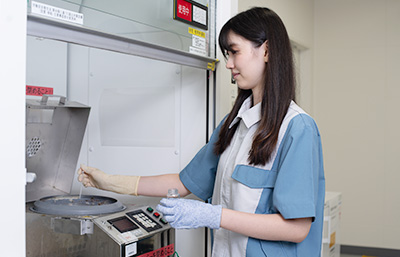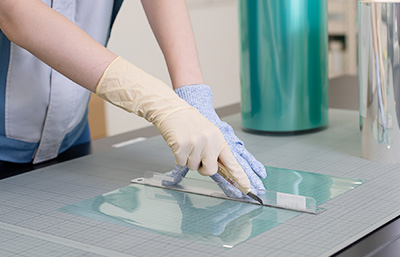Developer interviews
We have developed a unique manufacturing method that increases the density of the barrier layer.
Gas barrier film

Q. What kind of product is a gas barrier film?
And what applications are this kind of films used for?
They are not only thin and flexible but also less water vapor and oxygen penetrative, in short high-barrier.
With inorganic substances such as ceramic, we manufacture a barrier layer which is haundreds nm thick on plasitic films.
Gas barrier film is used in OLED(display panel and lighting), next-generation solar cells, electronic paper, and more.
Our gas barrier film protects devices from water vapor and oxygen.
Q. What are the advantages of using gas barrier film?
Conventional solar cells are used to have circuit elements on glass, but its component might be fragile, unfoldable, thick, and heavy.
On the other hand, when using thin and flexible films in stead of glass , the difference in water vapor transmission rate between glass and film causes the moisture deterioration.
In order to solve those problems, by adding our unique gas barrier properties to plastic films, it is possible to make products thinner, lighter, more bendable, and more foldable.
Next-generation solar cells which include perovskite solar cells are required to be flexible because they are expected to be applicable to various shapes of buildings.
Our gas barrier film enables solar cells to have both moisture-impermeability like glass and properties of thinness and flexibility like film.

Q. What are Lintec's strengths in gas barrier films?
We have developed a unique manufacturing method that increases the density of the barrier layer with our technologies of wet coating and surface improvement.
We actualize advanced high-barrier layer which is thin and flexible with our original method.
Q. Please share how difficult and interesting it is to Research and Development.
We struggled to develop highly reproducible gas barrier properties because it is necessary to surpress the permeability of incredibly small water molecules with gas barrier layer.
On the other hand it is interesting for me to improve products performance by considering the factors that affect gas barrier properties and refining.
While there were many unsatisfactory instances, identifying and improving the factors one-by-one leads to improve performance approximately 100 times compared to conventional products.
This experience made me feel pleased.

Q. What upcoming challenges and developments are you working on now?
We are expecting more and more development of devices are susceptible to moisture such as OLED, electronic paper devices, and next-generation solar cells.
We would like to contribute to makig them more flexible and lighter by producing films with properties that were uesd to be achievable by glass.

